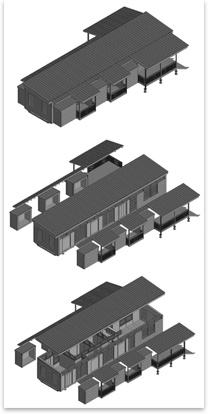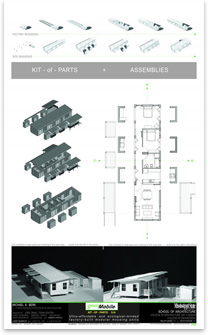
by Heather Livingston How do you . . . encourage and provide sustainable living to persons living in depressed rural conditions? Summary: For Michael Berk, the F.L. Crane Endowed Professor of Architecture at Mississippi State University, sustainable living truly is a matter for the masses. The architect is the creator of GreenMobile®, an affordable and sustainable mobile home that can be used on- or off-the-grid for disaster relief housing or for permanent residence. A winner of last year’s EPA Lifecycle Building Challenge, GreenMobile also was awarded $5.8 million from the Federal Emergency Management Agency (FEMA) Alternative Housing Pilot Program (AHPP) for the construction of 100 units on the Mississippi Gulf Coast in December 2006, though, as of yet, no units have been constructed. According to Berk, the project was first conceived in the 1990s, when Viking Range CEO Fred Carl provided Berk with seed funding to have his design studio students research and design experimental, low-cost, factory-built housing for the Delta regions of Mississippi. This work was additionally developed with significant grant funding from a HUD award to the School of Architecture’s Small Town Center in 2002. In 2005, the USDA further awarded the GreenMobile project a competitive Rural Business Enterprise Grant (RBEG). The $5.8 million FEMA award in 2006 under the AHPP program was given to expand the types of housing provided to disaster-affected communities by identifying, developing, and evaluating alternatives to traditional FEMA travel trailers and mobile homes.
A greener path Because Mississippi is a wood-producing state, GreenMobile would employ locally grown and harvested FSC-certified woods and veneers for the interior and SIPs, says Berk. For the exterior, Berk expects a fiber-cement siding to be used. Energy Star® appliances will include tankless water heaters and ceiling fans.
Next steps |
||
Copyright 2008 The American Institute of Architects. All rights reserved. Home Page |
||
home
news headlines
practice
business
design
recent related
› 21 Projects Honored in Inaugural Lifecycle Building Challenge
› FEMA Adopts Key AIA Recommendations on Katrina Housing
› Design Students Get Boxed In
Images courtesy of Mississippi State University and Michael Berk.
Design/Research Team
Faculty Assistants
• Dr. Larry Barrow, director, Digital Research Infomatics Lab
• Kimberly Brown, director, Carl Small Town Center
• Dr. Ralph Sinno, professor, civil engineering
• Dr. Keith Hodge, professor, mechanical engineering
Research, Design + Technical Assistants:
• Joseph Hagerman
• Marshall Graves
• Nick Hester
• Justin Taylor
• Jason Pressgrove
• Stuart Mays
Preliminary Research:
• Salvador Gil.
To learn more about GreenMobile, visit the Mississippi State University College of Architecture, Art + Design Web site.
Get more information on the EPA Lifecycle Building Challenge Awards.
See what resources are available through the AIA Committee on the Environment page on AIA.org.



